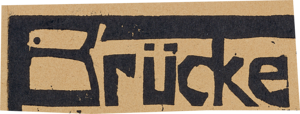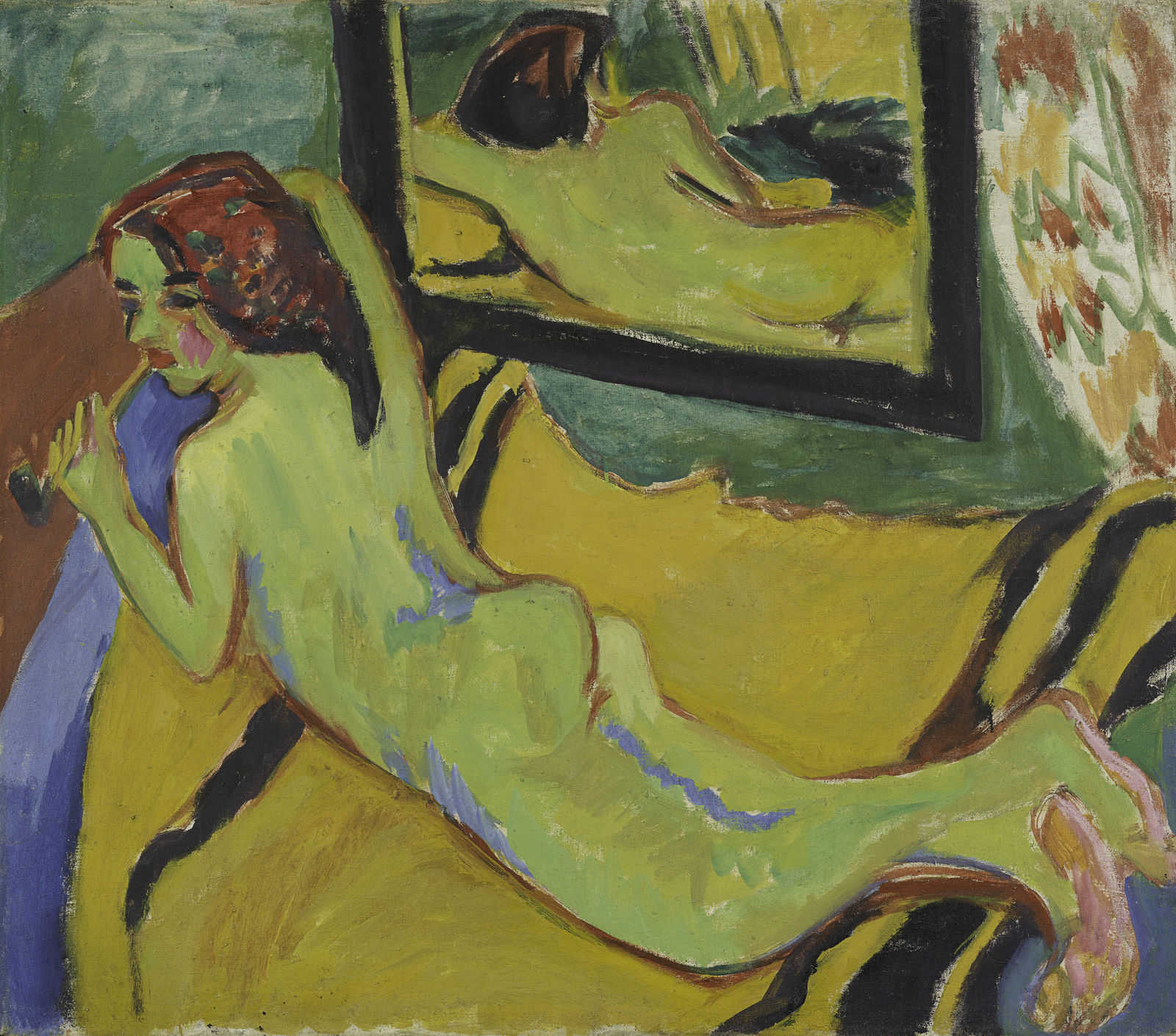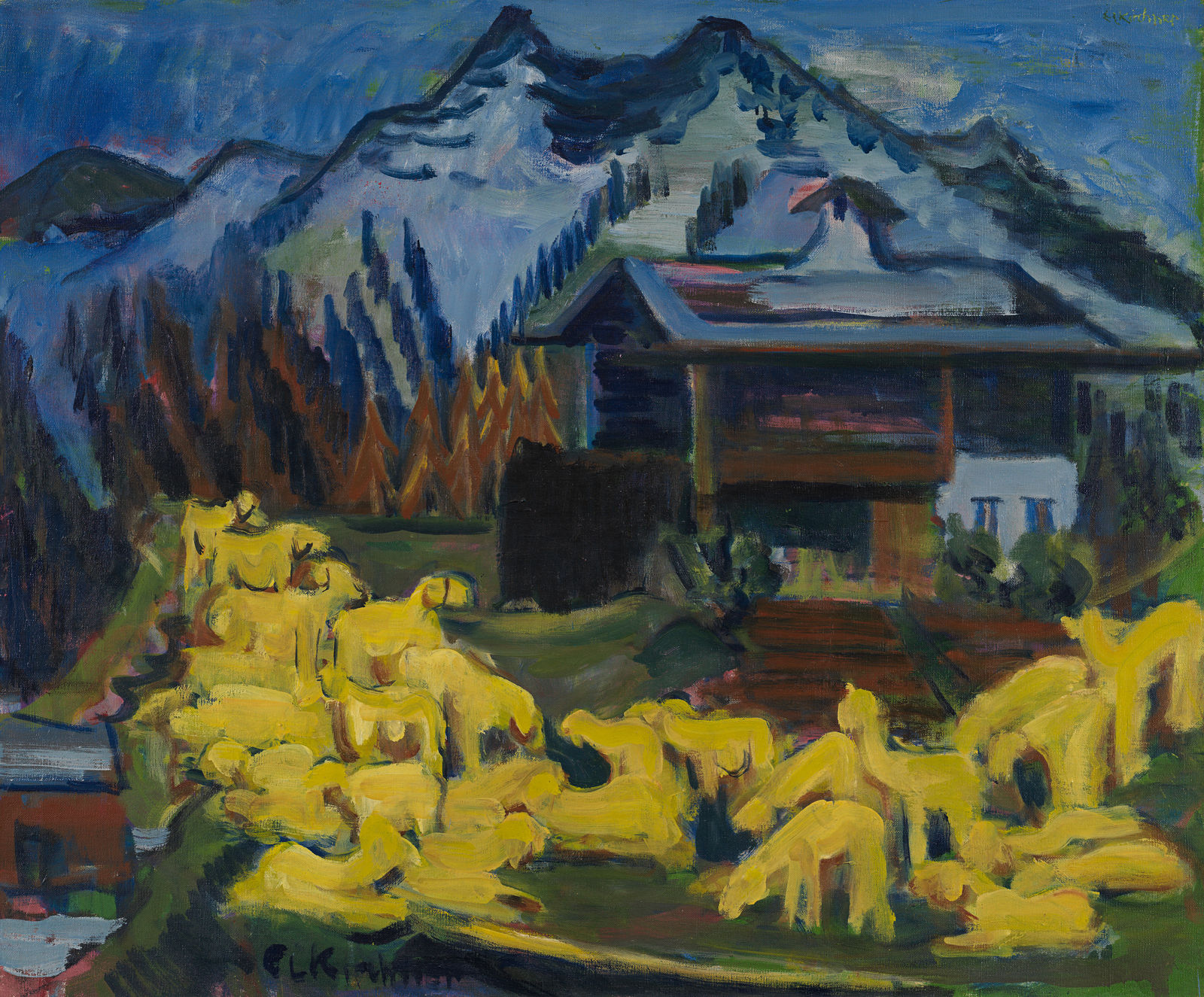Artist
Ernst Ludwig Kirchner
Born
6 May 1880, Aschaffenburg, Germany
Died
15 June 1938, Davos, Switzerland
Biography
Childhood and youth (1880–1901)
Ernst Ludwig Kirchner was born on 6 May 1880 in Aschaffenburg, the oldest son of Ernst and Maria Kirchner. His father worked as a chemical technician in the paper industry. 1 In his early years, Kirchner lived in Aschaffenburg with his parents and two younger brothers until the family moved to Frankfurt/Main in 1886. During his childhood Kirchner spent several years with his family in Switzerland, more precisely in Perlen nr. Lucerne (1887–1889) where Kirchner’s father was Deputy Director of a paper factory. Then, in 1890, the latter was appointed Professor of Paper Sciences at Chemnitz College of Technology. There, Kirchner attended the local grammar school, gaining his school-leaving certificate in 1901. Karl Schmidt-Rottluff and Erich Heckel were also educated in Chemnitz but attended a different school to Kirchner. There was at this point in time not yet any contact between the artist and the two teenagers who would later become his fellow Brücke colleagues.
Architecture studies in Dresden and founding of the Brücke group (1901–1911)
Kirchner went to Dresden to study Architecture and graduated in 1905 as a chartered engineer. However, in 1903-4 he also spent a semester in Munich, studying at the Royal Bavarian Polytechnic of Munich. During this time, he also attended the private art school of artists Wilhelm von Debschitz and Hermann Obrist, where he took classes in life drawing and composition. It was while he was in Dresden that Kirchner first met Fritz Bleyl and later also Heckel and Schmidt-Rottluff, who were likewise studying Architecture. The four young men shared a great interest in art and a desire to find a new means of artistic expression. On 7 June 1905, they founded the Brücke group. One year later the manifesto was drafted and Kirchner carved it in wood. In 1905, he began with the so-called quarter-hour nudes. The group members practised the rapid drawing of nude models both in the studio and outdoors. Another practice which came to be characteristic for the group and the way the artists worked was that of extensive summer stays. Kirchner preferred spending time at the Moritzburg lakes outside Dresden (1909–1911) and on the Baltic Sea island of Fehmarn (1908, summer 1910 and 1912–1914). Kirchner studied the works of non-European artists in the ethnological museums first in Dresden and later in Berlin and began to express his impressions in sculptures and furniture, amongst others.
Kirchner’s time in Berlin (1911–1914)
Following in the footsteps of Heckel and Max Pechstein, in autumn 1911 Kirchner moved to Berlin where he lived in a combined studio and apartment on Durlacher Strasse in Berlin’s Wilmersdorf district. Pechstein lived in the same building, which was close to restaurant Bieberbau where the artists would meet. To earn money the two artists set up the MUIM Institute (Moderner Unterricht in Malerei), but it proved to be a flop and they were obliged to abandon the venture as early as 1912. Numerous contacts to Berlin’s literary scene were made during this time, for example to author and psychiatrist Alfred Döblin, to the young writer Simon Guttmann or the main mouthpiece of Expressionist ideas, the journal “Der Sturm”. After a brief romance with dancer Gerda Schilling, from 1912 onwards Kirchner took up with her older sister Erna Schilling. His immediate surroundings began to assume a major role in his work with Berlin city scenes predominating. In 1913, he exhibited works in the Armory Show which began in New York before travelling to Chicago and finally to Boston. The exhibition caused a stir in America; not only was it the first presentation of the European avant-garde to an American audience but also marked Kirchner’s debut on the continent. After Pechstein left the Brücke group, the remaining members felt moved to reconfirm their beliefs in the Brücke chronicle, which was subsequently formulated by Kirchner, but his ideas were rejected by the other Brücke artists leaving its members at odds with one another. On 27 May 1913, the group disbanded. At the end of 1913, Kirchner and Erna Schilling moved to a studio in Körnerstrasse, in the prosperous Berlin district of Steglitz. Kirchner always treated his studios as artworks in their own right. 2 He documented his surroundings using photographs – a technique he had learned from Schmidt-Rottluff’s later wife Emy Frisch. 3 During this time, Kirchner focused on producing his so-called Berlin street scenes. 1914 saw an important solo exhibition for the artists in Kunstverein Jena, and it subsequently led to Kirchner forming close friendships with the archaeologist Botho Graef, his friend Hugo Biallowons, and philosopher Eberhard Grisebach, the director of the Kunstverein. That same year, Kirchner also got to know architect Henry van de Velde in connection with a presentation at the Werkbund exhibition in Cologne. In 1914, Kirchner and Erna Schilling spent their last summer on Fehmarn, until they were obliged to return to Berlin due to the outbreak of the First World War.
The First World War (1914–1917)
Kirchner was plagued by fears of the war and to avoid being drafted into a more serious role he volunteered to serve as a driver. However, he had to abandon training for that role as the result of what amounted to a nervous breakdown; he was declared to be unfit for service and discharged. Stays in various sanatoriums followed, these including in the Taunus region outside Frankfurt, in Berlin and in Switzerland. 4 His stay in Davos was organised by Eberhard Grisebach, whose wife was the daughter of Dr. Spengler, a local doctor.
Move to Switzerland (1917–1918)
In May 1917, Kirchner travelled to Switzerland again and spent the summer on the Stafelalp above Davos, where he was visited by Henry van de Velde, amongst others. From September and on van de Velde’s advice, Kirchner spent the autumn and winter in the Bellevue sanatorium in Kreuzlingen. During this time, he produced numerous prints depicting the clinic staff and his fellow patients. He made new acquaintances, getting to know author Leonhard Frank and artist Nele van de Velde, the daughter of Henry van de Velde, whose mentor Kirchner would become. During this period his companion Erna Schilling looked after the his business affairs in Berlin and nurtured his personal network in Germany. In May 1918, in memory of Botho Graef who died in April 1917 Kirchner set up the Botho-Graef Foundation for the Jenaer Kunstverein and gifted more than 250 prints and drawings to the institution. In July he returned to Davos.
Lärchenhaus and Wildbodenhaus (1918–1926)
Having spent the summer on the Stafelalp once again in September 1918 Kirchner moved to a house in the ensemble known as In den Lärchen in Davos’ Frauenkirch quarter. The artist began to carve his own furniture and as had been the case during his time in Berlin he started to explore his new surroundings through the medium of art. Kirchner produced characteristically coloured alpine landscapes, which are amongst the main works of his early time in Davos. Erna Schilling sent the first shipments of his belongings from Berlin including the printing press and carpets. She also sent numerous paintings as rolled-up canvases. Most of the frames remained in Berlin. In Switzerland, Kirchner began to reframe the works. The artist also produced designs for embroidery work for Erna Schilling and Helene Spengler, the wife of the doctor who was treating him. In 1920, he published for the first time under the pseudonym Louis de Marsalle, ostensibly a poet, art critic and physician. As in Kirchner’s eyes nobody had understood the essence of his work to date and his development as an artist his alter ego wrote about him. A large exhibition of Kirchner’s work in Kronprinzenpalais, Berlin in 1921 featuring 50 of his works demonstrated that he remained influential despite his distance from the centres of art. That same year Kirchner’s father died. In May during his stay in Zurich Kirchner got to know the dancer Nina Hard (1899–1971). She lived with him during the summer months and posed as a model for him on numerous occasions. Shortly afterwards he made the acquaintance of Lise Gujer (1893–1967). The weaver was to play a role in Kirchner’s life for many years and was the driving force behind their joint production of tapestries. 5 Erna Schilling then moved permanently to Davos and the couple abandoned their apartment in Berlin. In 1922, Kirchner first met the physician Frédéric Bauer (1883–1957) from the sanatorium in Davos, who would subsequently become one of his most important collectors and patrons. After disagreements with his landlords, the Müller family, and breaking with both the Spenglers and Grisebachs, Kirchner moved to the house “Auf dem Wildboden”, again in Frauenkirch. Bauer then took over from Dr Spenger and supervised Kirchner’s further medical treatment. The Schieflers spent longer periods of time with Kirchner in the Wildbodenhaus, as Gustav Schiefler wanted to create the first catalogue raisonné of the artist’s prints. Kirchner either recorded his guests in photographs or incorporated them into his works. And he received many guests in the “Wildboden” house: For example, Basle-based artist Hermann Scherer (1893 –1927) visited Kirchner in 1923, followed in 1924 by Edwin Redslob (1884–1973), who held the position of Imperial Art Protector during the interwar years. On New Year’s Eve 1924-5, he was visited by three of his Basle students – Paul Camenisch (1893–1970), Albert Müller (1897–1926) and Scherer – who founded the artist group Rot/Blau. Although he lived so far away from the art metropolises thanks to his frequent visitors in the 1920s Kirchner remained very well informed of events. And he received special recognition for his work in numerous exhibitions in this period. In 1925, in Berlin on the occasion of the spring exhibition of the Prussian Academy of Arts, Kirchner received the award “Preis der Republik” for his painting “Junkerboden”.
Kirchner’s journey to Germany and the late 1920s (1925–1929)
In December 1925, Kirchner travelled to Germany again for the first time and stayed until March 1926. Although in the previous years he had wanted nothing to do with his native country he now intended not only to visit his mother but also to cultivate useful contacts. The trip took him to Frankfurt, Chemnitz, Dresden and Berlin. In Berlin, he met Schmidt-Rottluff, who tried to persuade him to form a new artist grouping but Kirchner was against the idea. Following this longer stay in Germany he actually considered leaving Switzerland and moving back there. At any rate, from then onwards Kirchner spent time in Germany more adequately – and from 1929 Erna Schilling also travelled regularly to Berlin for medical treatment. However, in the early 1930s all their hopes of moving were dashed. In 1933, the Nazis seized power. Kirchner was initially merely curious but then increasingly concerned by political developments in Germany following Hitler’s coup. Returning to Germany was no longer an option.
The 1930s (1930–1938)
In the late 1920s numerous exhibitions were devoted to Kirchner; in 1928 his works were shown at the Venice Biennale. He was also in discussions with Ernst Gosebruch, the director of Folkwang Museum in Essen, about producing murals for the museum’s festive hall, but this project was never realized. In 1931, he took part in the exhibition “German Paintings and Sculpture” in the Museum of Modern Art in New York, while in 1933 an important retrospective was devoted to him in Kunsthalle Bern. On this occasion the final essay by Louis de Marsalle was printed in the catalogue accompanying the show that Kirchner was closely involved with; in effect, Kirchner abandoned his pseudonym in 1933. In view of the threat posed by the Nazis and the losses incurred by the difficulties in selling his work, Kirchner turned instead to the art scene in the United States and tried to form contacts there. When in 1937 the Nazis also removed his works from public collections, confiscated and then defamed then as part of the exhibition “Degenerate Art”, Kirchner felt deeply hurt. That same year he was expelled from the Prussian Academy that he had only recently joined in 1931. The annexation of Austria into Nazi Germany on 13 March 1938 fuelled Kirchner’s fears of a German invasion of Switzerland. To pre-empt more of his work being lost the artist destroyed some of his printing blocks and sculptures. The fact that there were no messages from Germany wishing him all the best for his 58th birthday only heightened his feelings of loneliness and isolation, while the situation in Germany and the country’s prospects seemed increasingly hopeless. In June, Kirchner cancelled his planned wedding to Erna. And shortly afterwards on 15 June 1938 he took his own life in front of his house Wildboden. Kirchner was buried in the nearby cemetery in Davos. At the time he was working on the painting Schafherde (Flock of Sheep). Today it is part of the collection of the Brücke-Museum.
Katrina Schulz
-
1The descriptions on the life and work of Kirchner are based amongst other things on the detailed biography that can be viewed on the website of the Kirchner Museum Davos, and the catalogue raisonné of the paintings by Donald E. Gordon, Ernst Ludwig Kirchner, (Cambridge, Massachusetts, 1968).
-
2See also: Hanna Strzoda, Die Ateliers Ernst Ludwig Kirchners. Eine Studie zur Rezeption ‘primitiver europäischer Und außereuropäischer’ Kulturen, (Petersberg, 2006).
-
3On the artist’s photographs see: Kirchner Museum Davos (ed.), Ernst Ludwig Kirchner. Fotografien – Werkverzeichnis und Kommentar. (Salenstein, 2005).
-
4Brücke-Museum (ed.), Ernst Ludwig Kirchner. Die Schweizer Jahre. From the collection E.W. Kornfeld, (Berlin, 2019).
-
5Bündner Kunstmuseum (ed.), Bildteppiche von Ernst Ludwig Kirchner und Lise Gujer. Ein Werkkatalog der Entwürfe, (Zurich, 2009).






